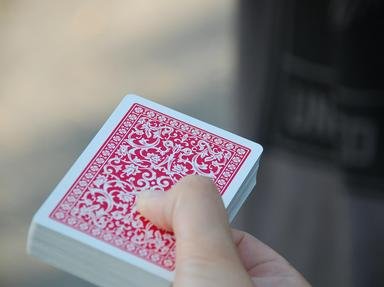Quiz Answer Key and Fun Facts
1. Two or more players try to shed their cards by matching the number or suit of the topmost discard. Eights are always wild, and permit the player to switch the suit in play. After one player goes out, the remaining ones are penalized according to the cards in their hands. What is this game called in the U.S.A.?
2. Although you can buy a deck made for this Victorian game, you can easily play it by using a Joker, or by removing one of the Queens or one of the Aces. Players draw cards from the others' hands (or are passed cards) and discard matching pairs. There is no definite winner, but there is one clear loser. What is this matching card game?
3. In this classic four-player trump game, two sets of partners remove cards numbered 2-8 and use only 24 cards following U.S. rules. Players take tricks, and Jacks are high. What is this game?
4. The most popular solitaire or patience game involves moving cards around seven columns, building four foundations based on aces, and drawing cards three at a time. The Brits call it Canfield, but in the U.S.A. it is known as...?
5. This shedding game resembles a solitaire or patience game for two or four people (or two sets of partners.). Kings are high, aces low. Cards are played on opposite color in descending sequence on four foundations laid out like a cross on the tableau, along with special foundation cards in each of four corners. Players draw from the stock and try to empty their hand first. What could this game possibly be?
6. In this evasion-type game, four players try to avoid taking tricks that contain hearts, or worse, the Queen of Spades - unless they are trying to "shoot the moon" (i.e. take every heart and the Black Lady). What game am I describing? (U.S. name, please).
7. A vying game is one in which players bet on who has the best hand. They may raise stakes or drop out before the comparison is made. The best known vying game in the world is Poker. It also has more versions than cards in the deck! Which of these is NOT a common, familiar variant played in the U.S.A.?
8. In this classic trick-taking game, one of the earliest, the players deal the cards and play tricks. The end. Well, all right, there's a little more. Two pairs of partners play. The final card dealt is turned up by the dealer; this indicates the trump suit. It remains on the table until the dealer plays his first trick. Each partnership scores one point per trick won (after ignoring the first six tricks won by each partnership). What is this vintage game?
9. In this more complicated trick-taking game, four players sit at North, South, East, and West at the table. North and South are partners, as are East and West. Ace is high; deuce is low. The dealer distributes all the cards. Players then bid on how many tricks they think they can take (and they specify a trump suit), or they may pass. Players get rewarded for meeting their "contract" and penalized for failing to do so. What game have I described?
10. In this game, players shed their cards through melding--laying down "sequences" (three or more consecutive cards of the same suit) or "books" (three or four cards of the same rank). A player may also "lay off" by adding to a meld on the table, or he may discard one card. The first to go out wins points based on the cards left in the other players' The target score for the game could be anywhere from 100 to 500. What game is this?
Source: Author
gracious1
This quiz was reviewed by FunTrivia editor
WesleyCrusher before going online.
Any errors found in FunTrivia content are routinely corrected through our feedback system.

